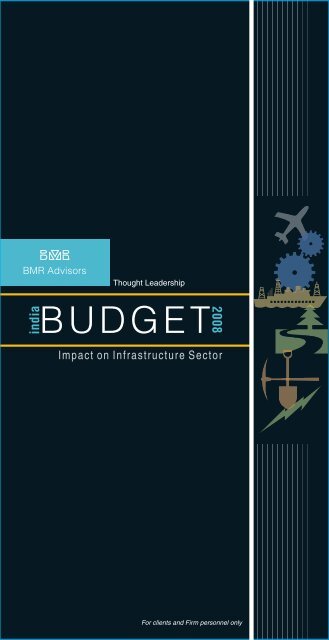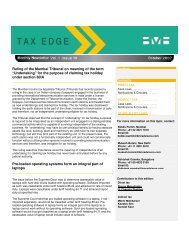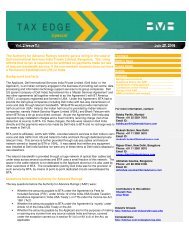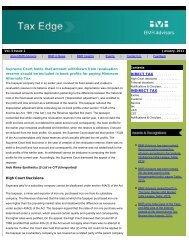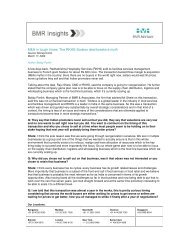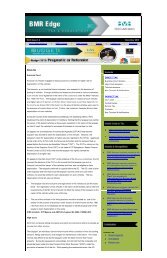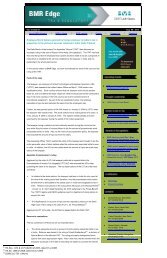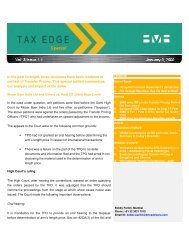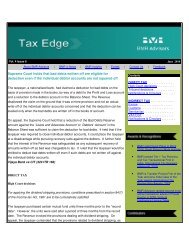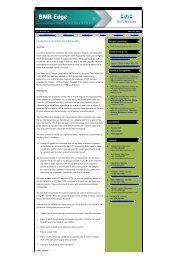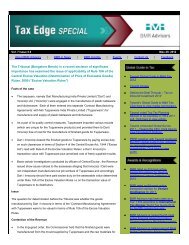BUDGET - BMR Advisors
BUDGET - BMR Advisors
BUDGET - BMR Advisors
You also want an ePaper? Increase the reach of your titles
YUMPU automatically turns print PDFs into web optimized ePapers that Google loves.
indiaThought Leadership<strong>BUDGET</strong>2008Impact on Infrastructure SectorFor clients and Firm personnel only
This publication provides general information existing as at thetime of preparation. The publication is meant for generalguidance and no responsibility for loss arising to any personacting or refraining from acting as a result of any materialcontained in this publication will be accepted by <strong>BMR</strong> <strong>Advisors</strong>. Itis recommended that professional advice be taken based on thespecific facts and circumstances. This publication does notsubstitute the need to refer to the original pronouncements.
C O N T E N T SFOREWORDECONOMIC INDICATORS AT A GLANCE35Infrastructure sector performance 5Coal 6Electricity 7Crude petroleum 8Petroleum refinery products 9Steel 10Cement 11Evolving infrastructure landscape 12POWER14Installed capacity 14Power generation 16Transmission 17Ultra mega power projects 17Power exchanges 18Policy developments 19Outlook 20AVIATION INFRASTRUCTURE23Developments during the year 23Policy developments 24Outlook 27PORTS30Developments during the year 30Policy developments 30Outlook 30india<strong>BUDGET</strong>20081
ROADS AND BRIDGES33Developments during the year 33Policy developments 34Outlook 35RAILWAYS37Developments during the year 37Policy developments 37Outlook 37WATER SUPPLY AND SANITATION40Outlook 40<strong>BUDGET</strong> EXPECTATIONS - POWER41Exchange control 41Income tax 41Excise and customs 42<strong>BUDGET</strong> EXPECTATIONS - AVIATION INFRASTRUCTURE44Income tax 44Service tax 45Excise and Customs 46Central sales tax 47<strong>BUDGET</strong> EXPECTATIONS - PORTS, ROADS AND BRIDGES,RAILWAYS, WATER AND SANITATION48Exchange control 48Income tax 48Excise and customs 49Service tax 51Central Sales Tax (CST) / Value Added Tax (VAT) 52<strong>BUDGET</strong> PROPOSALSGLOSSARY54692india<strong>BUDGET</strong>2008
FOREWORDInfrastructure is the backbone of every economy. SustainableGDP growth can be achieved, only if the infrastructurebottlenecks can be eased out with as much conviction as ispossible. The Government certainly deserves kudos for havingrecorded growth rate of over 8 percent in 12 successive quartersupto December 31, 2007 and it is bullish in achieving 8.8 percentin the current year too. It believes that the drivers of the growthwould be manufacturing and services. These two segments ofthe economy also play a critical role in the growth of theInfrastructure sector. Therefore, if one were to follow theinstincts of the Government, it would seem that growth in thesetwo critical segments of the economy is likely to spur the growthin the infrastructure sector as well.Often times, successive Finance Ministers have used taxpolicies as a tool to provide impetus to sectors that it desires toaugment. Over the years, the current Finance Minster hasshown reluctance towards using tax sops as a means to augergrowth and therefore, it is not surprising that this year, we do notfind any earth shattering tax exemptions / policies, which can besaid to be accorded to this sector.From his budget speech, it is abundantly clear that he desires touse increased budgetary support via creation of funds as a toolto help the sector. Notable to mention in this context would beincreased allocation to National Highway DevelopmentProgram, Rural Electrification Programme, Accelerated PowerDevelopment and Reforms Project, etc.While the creation of a national fund for Transmission andDistribution reforms, is a welcome move and would provide aboost to this very critical segment, on whom hinges the burden ofevacuating ( with least quantum of losses) the energy beinggenerated / expected to be generated by additional generatingcapacities planed/implemented, a bit of the euphoria, wouldvanish, given that import duty has been increased for thissegment as well, as has been done for the generatingcompanies which are non mega in nature.The Budget proposals also reinforced the Governmentsintention to continue pushing for Ultra Mega Power Plants, whichis certainly a positive sign for the Indian economy looking at theresults of the 3 UMPPs already awarded. In addition, creation ofindia<strong>BUDGET</strong>20083
coal regulator would also help for those depending on coal asfuel for generation of energy. However, one issue that continuesto remain mysterious is the future outline and contour of the“Mega Power Policy” itself. Issues such as - would there bereduction in the threshold capacity limits? Would CPPs andMerchant Power Plants be brought into the ambit of Mega PowerPlants? Would price preference or purchase preferencecondition for availing mega power benefits continue etc,continues to beg attention!Overall, the Budget seemed more focused on key fundamentalssuch as Education, Health, and Agriculture. While it wasexpected to be populist, given that this was the last effective yearof the present Government, apart from the waiver of the loans tofarmers, one has not witnessed much populism! Reduction ofexcise duty coupled with decreased personal taxes is expectedto push consumption demand, which was becoming a matter ofconcern for many in the overall industrial milieu.4india<strong>BUDGET</strong>2008
ECONOMIC INDICATORS AT A GLANCEIndia has embarked on an ambitious growth trajectory. Afterdemonstrating strong GDP growth figures for preceding fouryears, albeit with some moderation, this year too, the Indianeconomy has exhibited buoyant growth numbers. The GDPgrowth for first half of financial year (FY) 2007-08 (April-September) is estimated at 9.1 percent as compared with 9.9percent in the corresponding period of the previous year. The fullyear growth has been estimated at 8.7 percent.Increased economic activity has been witnessed across sectors.While agriculture and allied activities have recorded highergrowth this year, the growth in industrial and services sector hasbeen lower compared to the previous year. Agriculture sectorhas recorded a higher growth rate of 3.7 percent for FY 2007-08(April-September) as compared to 2.8 percent for thecorresponding period of the previous year. Industry recorded agrowth rate of 9.5 percent (11.0 percent for the previous year)and services sector recorded a growth rate of 10.5 percent (11.6percent for the previous year).Growth in the index of industrial production (IIP) moderated to9.2 percent during FY 2007-08 (April-November) against10.9 percent for the corresponding period of the previous year.Although, moderation has been witnessed in most of themanufacturing industry groups, there has been a sustained highgrowth in the capital goods sector which has primarily beendriven by capital expenditure undertaken by manufacturing firmsto augment production capacities.Infrastructure sector performanceIn the backdrop of developments during the H1 FY 2007-08, thesix core infrastructure industries, comprising 26.7 percent of theIIP, posted a lower growth of 6 percent during FY 2007 08 (April-November) as compared to 8.9 percent for the correspondingperiod of the previous year. When compared to previous yeargrowth rate, sluggishness has been observed in the coresectors. This sluggishness is primarily attributable to high baseeffect, under utilization of capacity in a few sectors owing toindustry specific constraint.india<strong>BUDGET</strong>20085
All the sectors within the core infrastructure sector, viz electricity,crude petroleum, petroleum refinery products, cement, coal andfinished steel registered lower growth during FY 2007-08 (April-November) compared to the corresponding period of theprevious year.P E R F O R M A N C E O F C O R E I N F R A S T RU C T U R EINDUSTRIES (WEIGHT IN IIP: 26.7 PERCENT)Source: MoS&PI, GoI dataGROWTH OF CORE INFRASTRUCTURE SECTORS (INPERCENT)Source: MoS&PI, GoI dataCoalCoal production (weight of 3.22 percent in the IIP) registered agrowth of 7.7 percent (provisional) in November, 2007 comparedto growth rate 4.9 percent in November, 2006.Cumulative coal production for FY 2007-08 (April-November)was 267 MMT compared to 256 MMT for the corresponding6india<strong>BUDGET</strong>2008
period of the previous year, registering a growth of 4.3 percentcompared to 4.8 percent during the corresponding period of theprevious year.PERFORMANCE OF COAL PRODUCTIONSource: MoS&PI, GoI dataGROWTH IN COAL PRODUCTION (IN PERCENT)Source: MoS&PI, GoI dataElectricityElectricity generation (weight of 10.17 percent in the IIP)registered a growth of 5.8 percent (provisional) in November2007 compared to a growth rate 8.8 percent in November, 2006.Cumulative electricity generation during FY 2007-08 (April-November) was 467 BU’s compared to 436 BU’s generatedduring the corresponding period of the previous year, registeringa growth rate of 7 percent compared to 7.3 percent during thecorresponding period of the previous year.india<strong>BUDGET</strong>20087
PERFORMANCE OF ELECTRICITY GENERATIONSource: MoS&PI, GoI dataGROWTH IN ELECTRICITY GENERATION (IN PERCENT)Source: MoS&PI, GoI dataCrude petroleumCrude petroleum production (weight of 4.17 percent in the IIP)registered a growth of 0.3 percent (provisional) in November,2007 compared to a growth rate of 9.8 percent in November,2006.Cumulative crude petroleum production during FY 2007-08(April-November) was 22.7 MMT compared to 22.6 MMTproduced during the corresponding period of the previous year,registering a growth of 0.6 percent compared to 5.4 percentduring the corresponding period of the previous year.PERFORMANCE OF CRUDE PETROLEUM PRODUCTIONSource: MoS&PI, GoI data8india<strong>BUDGET</strong>2008
GROWTH IN CRUDE PETROLEUM PRODUCTION (INPERCENT)Source: MoS&PI, GoI dataPetroleum Refinery ProductsPetroleum refinery production (weight of 2 percent in the IIP)registered a growth of 5.2 percent (provisional) in November,2007 compared to growth of 16.4 percent in November, 2006.Cumulative petroleum refinery production during FY 2007-08(April-November) was 96 MMT as against 88 MMT producedduring the corresponding period of the previous year, registeringa growth of 8.3 percent compared to 13.5 percent during thecorresponding period of the previous year.PERFORMANCE OF PETROLEUM REFINERYPRODUCTIONSource: MoS&PI, GoI dataindia<strong>BUDGET</strong>20089
GROWTH IN PETROLEUM REFINERY PRODUCTION (INPERCENT)Source: MoS&PI, GoI dataSteelFinished (carbon) steel production (weight of 5.13 percent in theIIP) registered a growth of 5.8 percent (provisional) inNovember, 2007 compared to 9.3 percent (estimated) inNovember, 2006.Cumulative finished (carbon) steel production during FY 200708 (April-November) was 33.6 MMT as against 31.7 MMTproduced during the corresponding period of the previous year,registering a growth of 5.9 percent (provisional) compared to11.6 percent during the corresponding period of the previousyear.PERFORMANCE OF FINISHED STEEL PRODUCTIONSource: MoS&PI, GoI data10india<strong>BUDGET</strong>2008
GROWTH IN STEEL PRODUCTION (IN PERCENT)Source: MoS&PI, GoI dataCementCement production (weight of 1.99 percent in the IIP) registereda growth of 4.5 percent (provisional) in November 2007compared to 11.8 percent in November, 2006.Cumulative cement production during FY 2007-08 (April-November) was 112 MMT as against 104 MMT produced duringthe corresponding period of the previous year, registering agrowth of 7.6 percent (provisional) compared to 10.6 percentduring the corresponding period of the previous year.PERFORMANCE OF CEMENT PRODUCTIONSource: MoS&PI, GoI dataGROWTH IN CEMENT PRODUCTION (IN PERCENT)Source: MoS&PI, GoI dataindia<strong>BUDGET</strong>200811
Evolving infrastructure landscapeEven as India continues to grow at over 8 percent, balancedincrease in the gross capital formation (GCF) in infrastructure asa proportion of GDP emerges as the most important necessitiesfor sustaining high economic growth. Recently, though therehave been investments in the infrastructure sector, the GCF as aproportion of GDP continues to be lower at around 3.5-4 percent.As far as the physical infrastructure is concerned, there exists ahuge deficiency.India’s GDP is projected to grow annually at an average rate of 9percent during the 11th Plan. When compared to the countriesin Asia, India’s investment level in infrastructure continues toremain low. GCF in infrastructure needs to be progressivelyaccelerated to higher levels.PROJECTED GDP AT MARKET PRICES AND GROWTHSource: Planning Commission, GoI dataAppreciating the significance of infrastructure development andthe severe bottleneck its non-existence could create in achievingthe targeted growth, today, the Government of India is focusedon infrastructure development more than ever before.Ambitious investment programmes for infrastructuredevelopment in certain sectors have been carved out by theGovernment. These sectors include electricity, roads, telecom,railways (including metro rail projects), ports, airports, storage,gas, irrigation, water supply and sanitation.The estimates of investments projected suggest a quantumjump in investments in infrastructure compared to the amount ofinvestments made during the 10th Plan. The GCF ininfrastructure is expected to rise from USD 63 billion in12india<strong>BUDGET</strong>2008
FY 2007-08 to 139 billion in FY 2011-12. The cumulative GCF ininfrastructure during the 11th Plan is projected at USD 488billion (Rs 20,018 billion). Thus, averages 7.44 percent grosscapital formation of GDP.GCF IN INFRASTRUCTURE AND ANNUAL TARGETS AS APERCENTGE OF GDPSource: Planning Commission, GoI dataindia<strong>BUDGET</strong>200813
POWERInstalled capacityAll India installed capacity of power as on January, 2008 was141,079.84 MW compared to 132,329 MW as on March, 2007,registering a growth of 6.6 percent. Of this, 74,453 MW (ie 53percent) is owned by the State, 47,350 MW (ie 34 percent) isowned by the Central and 19,275 MW (ie 14 percent) is ownedby the private sector. The total installed generation capacity ofcaptive power plants connected to grid is 14,636 MW.ALL INDIA INSTALLED GENERATION CAPACITYSource: CEA, GoI dataCapacity addition during the year was across thermal, hydro,nuclear and other renewable energy modes. Within thermalmode, capacity additions were primarily in coal and gas basedgeneration while diesel based generation continued to remainstagnant since March, 2005.Of the total installed capacity as on January, 2008, thermalbased installed capacity was 90,895 MW (ie 64 percent of thetotal installed capacity) which includes coal, gas and diesel. Coalbased installed capacity dominated the thermal basket with aninstalled capacity of 75,002 MW (ie 83 percent of the totalthermal capacity), followed by gas based installed capacity of14,691 MW (ie 16 percent of the total thermal capacity), followedby diesel with an installed capacity of 1,201 MW (ie 1 percent ofthe total thermal capacity).Nuclear based installed capacity was 4,120 MW (ie 3 percent ofthe total installed capacity). Hydro based installed capacity is35,208 MW (ie 25 percent of the total installed capacity).14india<strong>BUDGET</strong>2008
Renewable energy sources which include small hydro projects,bio-mass gasifier, biomass power, urban and industrial wastepower and wind energy had an aggregate installed capacity of10,855 MW (ie 8 percent of the total installed capacity).MODE WISE BREAK UP OF TOTAL INSTALLEDGENERATION CAPACITYSource: CEA, GoI dataMODE WISE BREAK UP OF INSTALLED THERMALGENERATION CAPACITYSource: CEA, GoI dataindia<strong>BUDGET</strong>200815
INCREMENTAL INSTALLED GENERATION CAPACITYDURING THE YEAR FY 2007-08 (APRIL-JANUARY)Source: CEA, GoI dataPower generationPower generation this year reflected moderate growthcompared to previous year. Against an all India targetedgeneration programme of 588 BU (710 BU for the full year) for FY2007-08 (April-January), energy generation of 586 BU wasachieved, registering an achievement of 99.7 percent of theproposed generation programme.Of this, thermal generation accounted for 458 BU (ie anachievement of 98 percent of the targeted programme), nucleargeneration accounted for 142 BU (ie an achievement of 76percent of the targeted generation programme) and hydroaccounted for 108 BU (ie an achievement of 113 percent of thetargeted generation programme).Notwithstanding the fact that many of the thermal power stationsin the country are very old, the plant load factor (PLF) has shownimprovement. The all India average PLF for the period FY 2007-08 (April-January) was recorded as 77.7 percent. Privateutilities recorded a PLF of over 90 percent, followed by Centralutilities at 86 percent and State utilities at 71 percent.In terms of demand and supply, the requirement of electricityacross India for the period FY 2007-08 (April-January) was 608BU and the corresponding availability was only 554 BU,registering an average deficit of 9 percent. Peak demand duringthe period FY 2007-08 (April-January) was 1070 MU and thecorresponding peak demand met was 907 MU registering anaverage deficit of 15 percent.16india<strong>BUDGET</strong>2008
TransmissionDuring the period FY 2007-08 (March-January), the all Indiainstalled transmission lines increased from 75,722 Km to 81,567Km for 400 kV transmission lines and 114,629 Km to 118,311Km for 220 kV transmission lines.During this period, several inter-regional transmission lines werecommissioned thereby providing stable operations intransferring power from surplus areas to deficit areas. This alsoincluded setting up of first 439 Km 765 kV transmission line.As on December 31, 2007 about 487,351 (ie 82.1 percent)villages stood electrified. In addition, 15.5 million (ie 78.9percent) of the potential pump sets were energized. 39,383villages were covered this year under the Rajiv Gandhi GrameenVidyutikaran Yojana (RGGVY). Of this, 21,541 villages wereelectrified.Ultra mega power projectsIndia has envisaged a capacity addition of 100,000 MW to meetits mission of “Power to All by 2012”. To achieve its target ofmeeting the growing requirements of power and to attract privatesector investments a unique initiative of developing Ultra MegaPower Projects (UMPP) under tariff based internationalcompetitive bidding route was launched by the Government.Development of 4,000 MW capacity project through tariff basedbidding process is a first of its kind. To facilitate tie-up of inputsand clearances, project specific shell companies have been setup as wholly owned subsidiaries of Power Finance CorporationLimited (PFC). These companies would take preliminarystudies and obtain clearances relating to water, land and fueland power offtake prior to the tie-up to award of the project.In a view to develop these UMPP’s each with a capacity of 4,000MW, 9 sites have been identified so far. These include 4 pit-headsites and coastal sites. For coastal sites usage of imported coalhas been envisaged. These projects are expected to add about36,000 MW within a span of 7-8 years.Mundra ultra mega power projectA 4,000 MW imported coal-based power project to be set up inGujarat, Mundra ultra mega power project is amongst the firstUMPP’s wherein the Government had invited bids for the projectindia<strong>BUDGET</strong>200817
under the tariff based competitive bidding. Tata PowerCompany Limited emerged as the successful bidder for theproject and was handed over the project on April 23, 2007 by theGovernment at the evaluated levelized tariff of Rs 2.26367 perkWhr.Sasan ultra mega power projectA 4,000 MW pit-head power project to be set up in MadhyaPradesh, Sasan ultra mega power project is also amongst thefirst UMPP’s wherein the Government had invited bids for theproject under the tariff based competitive bidding. ReliancePower Company Limited emerged as the successful bidder forthe project and was handed over the project on August 7, 2007by the Government at the evaluated levelized tariff of Rs 1.19616per kWhrKrishnapatnam ultra mega power projectA 4,000 MW imported coal-based power project to be set up inAndhra Pradesh is the third UMPP wherein the Government hadinvited bids for the project under the tariff based competitivebidding. Reliance Power Limited emerged as the successful L1bidder quoting a levelised tariff of Rs 2.33 per kWhr. A letter ofIntent for the same was issued to Reliance Power Limited onNovember 30, 2007.Tilaiya ultra mega power projectA 4,000 MW pit-head power project to be set up in Tilaiya Village,Jharkhand is the fourth UMPP wherein the Government hadinvited bids for the project under the tariff based competitivebidding. The RFQ stage in respect of Tilaiya UMPP wascompleted on November 12, 2007 and 13 bids have beenreceived. The bids are currently under evaluation.Power exchangesCERC has issued guidelines for setting up power exchanges. Ithas given approval to one application for setting up powerexchange. This would facilitate competition in the electricitysector.18india<strong>BUDGET</strong>2008
Policy developmentsElectricity (Amendment) Act, 2007An important policy initiative was taken by amending theElectricity Act.The Electricity (Amendment) Act, 2007, amended certainprovisions of the Electricity Act, 2003 which were enacted onMay 29, 2007 and further and brought into force with effect fromJune 15, 2007.The main features of the Amendment Act are:• Central Government, jointly with State Governments, toendeavor to provide access to electricity to all areasincluding villages and hamlets through rural electricityinfrastructure and electrification of house-holds• No License required for sale from captive units• Deletion of the provision for elimination of cross- subsidies.The provision for reduction of cross subsidies wouldcontinue• Definition of theft expanded to cover use of tamperedmeters and use for unauthorized purpose. Theft madeexplicitly cognizable and non-bailableRules under Electricity Act, 2003The Central Government has issued the following Rules underthe Electricity Act, 2003 during this year.• The Central Government has notified Appellate Tribunal forElectricity (Procedure, Form, Fee and Record ofProceedings) Rules, 2007 on January 22, 2007, which havereplaced the Appellate Tribunal for Electricity (Form,Verification and Fee for filing an appeal) Rules, 2004 notifiedon April 13, 2004• Central Electricity Regulatory Commission Fund(Constitution and the manner of application, of the Fund)and Form and Time for Preparation of Budget Rules, 2007notified on October 22, 2007india<strong>BUDGET</strong>200819
• Central Electricity Regulatory Commission (Form of AnnualStatement of Accounts and Records) Rules, 2007 notifiedon October 22, 2007OutlookPower sector in India is at a very important stage ofdevelopment. Although significant generation capacity hasbeen added in the past, with intensifying economic momentum,demand supply mismatch continues to widen. In order to meetthe rising demand, the 11th Plan aims at adding 78,577 MWgeneration capacity.thProjected investments in electricity during the 11PlanDuring the 10th Plan, the total investment outlay in the powersector was to the tune of Rs 2,918 billion (USD 71 billion). Duringthe 11th Plan, the total investment in the electricity sector isprojected to scale up to Rs 7,253 billion (USD 177 billion).Based on these projections, 76 percent of the investment isanticipated to come from the public sector and the balance 24percent is anticipated to come from the private sector.PROJECTED INVESTMENT IN THE POWER SECTOR (INUSD BILLION)Source: Planning Commission, GoI dataOver the next five years, 56 percent of the investments isprojected to be expended on creating power generationcapacity, 21 percent on transmission and 23 percent ondistribution.20india<strong>BUDGET</strong>2008
PROJECTED INVESTMENT IN THE POWER SECTOR (INUSD BILLION)Source: Planning Commission, GoI dataPROJECTED INVESTMENT IN THE POWER SECTOR (INUSD BILLION)Source: Planning Commission, GoI dataWindow of opportunity5 Ultra mega power projects to be announced forbiddingBidding process in respect of five proposed UMPP’s in States ofOrissa, Tamil Nadu, Chattisgarh, Maharashtra and Karnataka isabout to be kicked-off by the Government. The kick-off iscontingent upon necessary clearances / tie up from therespective State Governments which are being activelyperused.india<strong>BUDGET</strong>200821
Merchant power plantsThe Ministry of Power has issued guidelines for setting up MPP'sfor which fuel tie-up would be facilitated. Unlike traditionalutilities, MPP’s compete for customers and absorb full marketrisk. They are market based response to growing electricitydemand. There are no guarantees for minimum offtake.22india<strong>BUDGET</strong>2008
AVIATION INFRASTRUCTUREAs India’s economy has captured world imagination, Indianaviation sector too is experiencing an unprecedented growth.The domestic passenger carriage, cargo movement andinternational air traffic have shown exponential growth. Thebenefits of growth are attributable to the policy of increasedliberalization both on domestic and international sectors. Theyear 2007 has been remarkable with regards to the growthwitnessed in passenger traffic. During the year 2007 (January toSeptember), domestic airline passenger traffic has registered agrowth of 36.74 percent. Further, the scheduled domestic airservices are now available to / from 82 airports as against 75 in2006.Developments during the yearInternational operationsThe Government decided to open the India-Gulf route to eligibleprivate schedule carriers with effect from January 1, 2008. JetAirways has been permitted to operate international services tocertain destinations in the Gulf region from January 1, 2008.Development of airport infrastructureDevelopment of airport infrastructure is being undertakenthrough the public-private partnership route in major metro citieslike Delhi, Mumbai, Bangalore and Hyderabad. Furthermodernization of the Kolkata and Chennai airport are also beingundertaken.Modernization of Delhi and Mumbai airportThe International airports in Delhi and Mumbai have beenrestructured and are being modernized through private sectorparticipation. The construction of first phase of Delhi airportstarted in January, 2007 and is likely to be completed by March,2010. The cost of first phase of development is approximatelyRs 88.9 billion.The construction work of Mumbai airport also started in January,2007. The airport will be saturated by 2014 with capacity of 40million passengers per annum. The cost of development is Rs70 billion approximately.india<strong>BUDGET</strong>200823
Hyderabad International Airport Limited (HIAL)A Greenfield airport is being developed in Shamshabad, nearHyderabad on BOOT basis under public-private participation bythe Government of Andhra Pradesh. The approximate cost ofthe Project is Rs 24.8 billion. Airport Authority of India (AAI) andGovernment of Andhra Pradesh together hold 26 percent equitywith AAI’s equity being capped at Rs 500 million. The balance74 percent is held by the strategic partner, a consortiumconsisting of GMR Enterprises and Malaysian Airports HoldingsBerhard (MAHB). The trial run was successfully conducted onFebruary 18, 2008. The airport is scheduled to commence itsfull-scale operations on March 16, 2008.Bangalore International Airport Limited (BIAL)Greenfield airport project at Devanahalli near Bangalore isbeing implemented on a BOOT basis for 30 years under thepublic-private participation at a revised cost of Rs 24.7 billion.Government of Karnataka and AAI together hold 26 percentequity and the strategic joint venture partners hold the balance74 percent. The target date of opening of the airport is March 30,2008.Policy developmentsPolicy for greenfield airportsIn order to streamline the policy framework for setting up of newairports an Inter Ministerial Group (IMG) was set up to examinethe extant procedures and recommend a new policy forgreenfield airports. The Policy aims at providing a clear-cutarchitecture of the approval mechanism for setting up of newairports. Guidelines for granting technical approvals byprescribed agencies involved in setting up of an airport would beprovided upfront.The policy is likely to be finalized in a couple of months.Aircraft (Amendment) Bill, 2007 (Amendment to theAircraft Act, 1934Keeping in view various developments in the civil aviation sectorin the past few years, a review of the existing provisions of theAircraft Act, 1934 was undertaken and it was considered24india<strong>BUDGET</strong>2008
necessary to carry out amendments to make it more effectiveand consistent with the present requirements.Through the Amendment to the Aircraft Act, for ensuring safetyand security control, the Central Government will be empoweredto make rules on:• Licensing of personnel engaged in air traffic control• Certification, inspection and regulation of communication,navigation and surveillance / air traffic managementfacilities• Safeguarding civil aviation against acts of unlawfulinterference and ensuring civil aviation security since atpresent there is no legal provision under which the variousorders on security are issuedThe existing power of Directorate General of Civil Aviation(DGCA) has been enlarged to issue directions on:• Regulation of air transport services (eg aircraft operations,air traffic control or maintenance and operation of anyaerodrome, communications, navigation, surveillance andair traffic management)• Prohibition of slaughtering and flaying of animals etc. within10 Km radius of the airportsA new clause in the Aircraft Act has been added to exerciseregulatory control on foreign registered aircraft coming to orflying over India.Promotion of regional air connectivityTo expand air connectivity on Tier II and Tier III cities and topromote regional air connectivity, a separate category of permit,Scheduled Air Transport (Regional) Services has beenintroduced. Accordingly, DGCA on August 28, 2007 has issuedCivil Aviation Requirements (CAR) stipulating minimumrequirements for grant of permit to operate Scheduled AirTransport Regional Services.india<strong>BUDGET</strong>200825
Establishment of Airport Economic RegulatoryAuthority (AERA)With the objective of creating a level playing field, to fosterhealthy competition amongst all airports, encourage investmentin airport facilities, regulation of tariffs of aeronautical services,protection of reasonable interest of users, operation of efficient,economic and viable airports, etc, it was decided to set up anAERA.The functions of the AERA are as under:• To fix, review and approve tariff structure for aeronauticalservices taking into consideration the capital expenditureincurred, the service provided, its quality and other relevantfactors• To fix, review and approve users development fees whichmay be levied by service provider for development of anairport• To monitor the set performance standards relating to quality,continuity and reliability of service as prescribed by CentralGovernment or its authorized agencies through concessionagreement or such other agreement• To call for such information required to review the regulatedtariff structure• To perform such other functions as may be entrusted to it bythe Central Government or as may be necessary to carryout the provisions of this ActAirports Economic Regulatory Authority of India Bill, 2007 wasintroduced in the Lok Sabha on September 5, 2007. The Bill hasbeen referred to the Department-related ParliamentaryStanding Committee on Transport, Tourism, and Culture forexamination and report within three months.Civil aviation co-operation programmeAn Aviation Co-operation Programme (ACP) has been signedwith USA during the visit of the Minister (Civil Aviation) in June,2007, which is to be funded through US Trade and DevelopmentAgency (USTDA). The proposed ACP is a public-privatepartnership between the USTDA, the Federal AviationAdministration (FAA) and US Aviation companies.26india<strong>BUDGET</strong>2008
The ACP is designed to provide a forum for communicationbetween the Government of India and US public and privatesector entities in India. The initial funding of the Programme isproposed through the public institutions of USA and privatecompanies having stakes in aviation. The ACP’s specificobjectives are:1. To promote increased safety, operational efficiency andsystem capacity in the Indian aviation sector2. Facilitate and coordinate aviation industry training andtechnical ties between the U.S. and India; and3. Strengthen overall US - India aviation cooperationOutlookWith aviation sector has been complementing economic growth.With significant contribution by the aviation sector towardseconomic growth, under the 11th Plan, a huge impetus is beinggiven to investments in this sector. Given the large scaleinvestments, this sector is all set to scale new highs.Projected investments in the airport sector duringthe 11th PlanDuring the 10th Plan, the total investment outlay in the airportsector was to the tune of Rs 68 billion (USD 1.65 billion). Duringthe 11th Plan, the total investment in this sector is projected toscale up to Rs 409 billion (USD 10 billion).PROJECTED INVESTMENT IN THE AIRPORT SECTOR (INUSD BILLION)Source: Planning Commission, GoI dataindia<strong>BUDGET</strong>200827
SEGMENT WISE PROJECTED INVESTMENT IN THEAIRPORT SECTOR (IN USD BILLION)Source: Planning Commission, GoI dataWindow of opportunityDuring the 11th Plan, several activities including development ofgreen field airports, modernization and redevelopment of metroand non-metro airports, etc have been lined up.Construction of an international airport in NaviMumbaiGovernment of India has given “in-principle” approval for thesetting up of a greenfield airport through public-privatepartnership at Navi Mumbai, Maharashtra a steering committeehas been set up by the Government to monitor theimplementation this project. Till date, 3 meetings of the saidcommittee have been heldModernization / expansion of Kolkata airportThe Ministry of Civil Aviation has approved the action plan fordevelopment of Kolkata airport. The proposal involvesconstruction of an integrated terminal building to handle 20million passengers per annum and airside works at a total cost ofRs 19.5 billion to be completed by June, 2010.Expansion / modernization of Chennai airportAn Inter-Ministerial Group (IMG) under the Chairmanship ofSecretary, Ministry of Civil Aviation, has approved an action planfor development of Chennai airport. The proposal involvesexpansion of international and domestic terminal building tohandle additional 13 million passengers per annum and majorairside work, including extension of secondary runway at a total28india<strong>BUDGET</strong>2008
estimated cost of Rs 18.08 billion, for completion in June, 2010.Modernization of 35 non-metro airportsAAI has undertaken an ambitions project of modernization of 35non-metro airports. As per a decision taken by the Committeeon Infrastructure, airside work, including construction of terminalbuildings, would be undertaken by AAI. Work on most of theseairports has been taken up. The work at Agra airport has beencompleted and major work at 7 other airports viz Agatti,Ahmedabad, Amritsar, Jaipur, Nagpur, Trichy and Udaipur isscheduled to be completed within the current financial year.It is expected that terminal buildings and associated air sideworks in respect of 24 airports will be completed by end March2009 whereas remaining 11 airports would be completed by endMarch, 2010.City side development of 24 select non-metro airports would betaken through public-private partnership. The city sidedevelopment includes commercial exploitation andmaintenance of terminal buildings besides real estatedevelopment. RFQ for Amritsar and Udaipur has already beenissued and the bids have been received. The initial responsefrom prospective bidders has been promising.Promoting cargo operationsThe cargo activities, at present, are much below the potentialavailable in the country. One of the steps contemplated is topromote cargo operations through public-private partnership atnon-metro airports.Airport connectivityThe Ministry has also taken up the issue of improvingconnectivity to major airports and selected 12 airports in the firstphase. These are international airport at Mumbai and theproposed Navi Mumbai, IGI Airport at Delhi and the proposedGreater Noida airport at Jawar, Chennai airport, Bangaloreairport, Kolkata airport, Hyderabad airport, Ahmedabad airport,Cochin airport, Coimbatore airport and Jaipur airport.The Ministry has firmed up various connectivity plans for 4 of theabove airports and is working on similar proposals for theremaining airports.india<strong>BUDGET</strong>200829
PORTSDevelopments during the yearThe expansion and modernization of ports remained amongstthe top priority areas of the Government during the year 2007.Several developmental projects got underway at the major portsduring the year. The year also witnessed significant growth intraffic and capacity at ports and also the growth in IndianTonnage. During FY 2007-08(April-November), the traffichandled was 333.27 MMT as against 294.60 MMT in thecorresponding period in the previous year, registering a growthof 13 percent.Policy developmentsModel concession agreement for portsIn a step towards creating a strong framework of attractingprivate sector investments for development of portinfrastructure, a draft MCA for ports under the public-privatepartnership was finalized and is under process for obtainingapproval of the Government.Cruise shipping policyThe National cruise shipping policy is on the anvil.OutlookUnder the 11th Plan, a huge impetus is being given toinvestments in ports in view of its key role in international tradeand its contribution to economic growth. Keeping in view thepresent trend, it is estimated that Indian ports will have to cargotraffic of about 800 MMT by FY 2011-12 as compared to 520MMT handled in FY 2004-05.Projected investments in the port sector during the11th PlanDuring the 10th Plan, the total investment outlay in the portsector was to the tune of Rs 40 billion (approximately USD 1billion). During the 11th Plan, the total investment in this sector30india<strong>BUDGET</strong>2008
is projected to scale up to Rs 869 billion (USD 21.2 billion). Ofthis, 64 percent of the cumulative investment is expected to bespent on development of major ports and the balance 36 percenton development of minor ports. Further, 74 percent of the totalinvestment is expected to come from the private sector and thebalance 26 percent from the public sector.PROJECTED INVESTMENT IN PORTS (IN USD BILLION)Source: Planning Commission, GoI dataSECTOR WISE PROJECTED INVESTMENT IN MAJORPORTS (IN USD BILLION)Source: Planning Commission, GoI dataindia<strong>BUDGET</strong>200831
SECTOR WISE PROJECTED INVESTMENT IN MINORPORTS (IN USD BILLION)Source: Planning Commission, GoI dataWindow of opportunityDuring the year, the perspective plans have been prepared for12 major ports along with a consolidated National DevelopmentPlan. These plans are expected to serve as guides for the majorports in preparing their annual plans and undertaking variousdevelopmental projects in future.32india<strong>BUDGET</strong>2008
ROADS AND BRIDGESIndia has one of the largest road networks in the worldaggregating to about 3.34 million Km. The road networkconsists of 66,754 Km of National Highways (NH), 128,000 Kmof State Highways (SH), 470,000 Km of Major District Roads(MDRs) and about 2,650,000 Km of Other District and RuralRoads (ODRRs).Developments during the yearThe Government’s approval for construction of ring roads / bypassesetc around the major cities across the country,upgradation of NHs and approval of modified programme forwidening of NHs marked the major activities during the year2007. Overall achievements made under different schemes ofdevelopment during the FY 2007-08(January-October), are asunder.TARGETS AND ACHIEVEMENTS DURING THE YEARParticulars Target AchievementWidening of 4 lane (Km) 1649.35 1065.98Strengthening of weak pavement 839 186Widening of 2 lanes (Km) 783.08 847.6Improvement of riding quality (Km) 1477.87 1525.55Rehabilitation/Constructionof bridges (No) 97 97Construction of by-passes (No) 8 2Improvement of lowgrade sections (Km) 20.85 41.47Source: GoI dataThe largest highway projects ever undertaken in the country arebeing implemented by the National Highway Authority of India(NHAI).india<strong>BUDGET</strong>200833
Golden QuadrilateralOut of total length of 5,846 Km, four laning of 5,629 Km has beencompleted and the balance length is under implementation.During the 128 Km length has been completed.North-South & East-West corridorsOut of total length of 7,300 Km for four laning, 1,559 Km lengthhas been completed and 4,762 km length is underimplementation. The remaining length is under various stagestowards award of work.Port connectivity project and other nationalhighwaysUnder port connectivity, out of 380 Km, 163 Km has beencompleted and 211 Km is under implementation. The work is yetto be awarded in remaining length. Out of 945 Km of othernational highway, so far 337 Km has been completed and 4laning of 605 Km is under implementation. During the calendaryear 28 Km length has been completed for the port connectivity.Public-private partnershipHistorically, investments in infrastructure, particularly in thehighways, were being implemented by the Government mainlybecause of the large volumes of resources required, longgestation period, uncertain returns and associated externalities.The galloping resource requirements, concerns for managerialefficiency and consumer responsiveness have led in the recenttimes to an active involvement of private sectorSo far 82 projects valued about Rs 231 billion on Build Operateand Transfer (BOT) basis (Toll based projects) have beenawarded. Out of this, 32 projects have been completed and 50projects are under progress. During the year, 10 contracts for698 Km of length have been awarded on BOT (Toll) basis.Policy developmentsCarriage by Road Act, 2007The carriage by Road Act, 2007 been notified in the Gazette ofIndia on October 1, 2007. The new Act would replace the34india<strong>BUDGET</strong>2008
Carriers’ Act, 1865 and would cater to the need of the modernday trade and transport by road. The new Act would help tomake the transport system transparent and modernize thesystems and procedures of the transportation trade throughregistration of common carrier. It also provides scope forapportionment of liability between the common carrier and theconsignor.Accreditation of bus body buildersThe Rules for accreditation of bus body builders has beennotified the on March 23, 2007. As per these Rules, the busbody builders in the country would be accredited through thesystem of zonal and national level accreditation Board. It isexpected that these Rules would come into effect from March23, 2008. This would bring uniformity in the bus body design andenhance safety and comfort to the passenger.OutlookUnder the 11th Plan, a huge impetus is being given toinvestments in roads in view of its key role in connectivity andtrade facilitation.Projected investments in the roads and bridgessector during the 11th PlanDuring the 10th Plan, the total investment outlay in the roadsector was to the tune of Rs 1,448 billion (approximately USD 35billion). During the 11th Plan, the total investment in this sectoris projected to scale up to Rs 3,668 billion (USD 89 billion).PROJECTED INVESTMENT IN THE ROAD SECTOR (IN USDBILLION)Source: Planning Commission, GoI dataBREAK UP OF INVESTMENT IN THE ROAD SECTOR (INindia<strong>BUDGET</strong>200835
USD BILLION)Source: Planning Commission, GoI dataSEGMENT WISE PROJECTED INVESTMENT IN THE ROADSECTOR (IN USD BILLION)Source: Planning Commission, GoI data36india<strong>BUDGET</strong>2008
RAILWAYSThe Indian Railways is the world’s second largest network in theworld and has been contributing to the industrial and economicdevelopment of the country for decades. Freight and passengertraffic are the two major segments of the Railways. Within thefreight, bulk traffic accounts for nearly 84 percent of the revenueearning freight traffic, of which 43 percent is coal.Developments during the yearThe year 2007 has been significant for the Indian Railways inachieving goals and targets. During FY 2007-08 (April-November), Indian Railways carried 501.46 MMT of revenueearning freight. The freight carried shows an increase of 37.07MMT over the freight traffic of 464.39 MMT carried during thecorresponding period last year, registering an increase of 7.98percent.Policy developmentsIn order to develop the wagon leasing market, a new wagonleasing policy has been prepared under which, rail customersand container operators will be able to take wagons on lease.For getting registered under the scheme, wagon leasingcompanies should have minimum net worth of Rs 2.5 billion andwill have a deposit Rs. 50 million as registration fee. Registrationwill be valid for 20 years and will be renewable for another 10years on rendering satisfactory services. Leasing companieshave been give full rights to choose or change their lessees.These companies will lease out special purpose wagons, highcapacity wagons and container wagons.OutlookProjected investments in the Railway sector duringthe 11th PlanDuring the 10th Plan, the total investment outlay in the Railwayssector was to the tune of Rs 1,196 billion (Approximately USD 29billion). During the 11th Plan, a huge impetus has given toinvestments in Railways sector.In a bid to make Indian Railways the world’s number one railwayindia<strong>BUDGET</strong>200837
network, significant investments has been proposed during the11th Plan in areas including construction of dedicated freightcorridors, new railways lines, modernization andredevelopment, world class railway stations, introduction ofprivate entities in container trains, etc. The total investmentoutlay in this sector is projected to scale up to Rs 3,035 billion(USD 74 billion)PROJECTED INVESTMENTS IN THE RAILWAYS SECTOR(IN USD BILLION)Source: Planning Commission, GoI dataSEGMENT WISE PROJECTED INVESTMENTS IN THERAILWAYS SECTOR (IN USD BILLION)Source: Planning Commission, GoI dataWindow of opportunityDedicated freight corridors• The construction work of Eastern freight corridor fromLudhiana to Dankuni situated near Kolkata and Westerncorridor from Delhi to JNPT will commence in 2008-09 a an38india<strong>BUDGET</strong>2008
estimated cost of Rs 280 billion• Detailed feasibility study for North-South, East-West, East-South and South-South dedicated Freight Corridors whichwere announced in FY 2007-08 will be expedited this fiscal• New and dedicated iron ore routes to be upgraded /constructedTerminal projects• Development of bulk and non-bulk goods terminals Metrorail transport project• Metro rail project in Mumbai and Bangalore, HyderabadOther projects• Procurement of rolling stock which include 20,000 wagons,250 diesel and 220 electric locomotives• Public-private partnership projects worth Rs 1000 billion tobe launched over the next 5 years for attracting aninvestment for developing world class stations, rolling stockand multi-modal logistics park• Concessions of Rs 250 billion likely to be awarded underpublic-private partnership during FY 2008-09 for developingNew Delhi, CST Mumbai, Patna and Secunderabad railwaystationsindia<strong>BUDGET</strong>200839
WATER SUPPLY AND SANITATIONIn view of the low levels of capital formation in this sector in thepast increased coverage is being give to this sector 11th Planhas projected a quantum jump in this sector. Increasedurbanization has led to a renewed interest on addressing thebacklog in investments in urban and sanitation infrastructure.OutlookProjected investments in the water an sanitationsector during the 11th PlanDuring the 10th Plan, the total investment outlay in this sectorwas to the tune of Rs 648 billion (approximately USD 16 billion).During the 11th Plan, the total investment in this sector isprojected to scale up to Rs 2,342 billion (USD 57 billion).PROJECTED INVESTMENTS IN THE WATER SUPPLY ANDSANITATION SECTOR (IN USD BILLION)Source: Planning Commission, GoI data40india<strong>BUDGET</strong>2008
<strong>BUDGET</strong> EXPECTATIONS - POWERThe major expectations of the industry from the forthcomingbudget are outlined below:Exchange controlEasing of external commercial borrowings norms forRupee expendituresIn 2007, the RBI put an embargo on utilization of ECB in excessof USD 20 million for Rupee expenditure per borrower perfinancial year. Although, the RBI’s move was intended to curbthe unabated inflows of foreign debts causing sectoralimbalances in the economy, the move has however, resulted inunintended hardship to the infrastructure projects (includingseveral upcoming mega power projects) having huge Rupeecapital expenditures.To provide much needed fillip for growth of the power sector inthe country, it is expected that the ECB norms for Rupeeexpenditures may be eased for the eligible power projects.Income taxExtending tax holiday for undertaking engaged ingeneration and distribution of powerUnder the current regime, an undertaking engaged ingeneration, generation and distribution of power is eligible to a10 year tax holiday under provided the undertaking begins togenerate power any time before March 31, 2010.Keeping in perspective the planned allocation for the powersector in 11th Plan, huge investment is anticipated to beundertaken in the sector in year 2010 and 2011. Also, in view ofthe ever increasing thrust for growth of the sector, significantallocation of planned expenditure can be expected to spill over inthe 12th Plan as well.However, due to the sunset clause in the tax holiday provisions,future investment in this sector may not be eligible for tax holiday.To ensure the competitiveness of the sector, it is expected thatthe sunset clause of March 31, 2010 may be extended.india<strong>BUDGET</strong>200841
Exemption from Minimum Alternate Tax (MAT)Under the extant regime, a power generating undertakingeligible to a tax holiday is liable to pay a MAT at the rate of 11.33percent on its book profits during the tax holiday period. Also,the credit of MAT paid during initial few years during tax holiday isalso lost since MAT credit can be carried forward only for 7consecutive years.The liability to MAT during tax holiday period to a great extentoffsets the benefits of tax holiday and defies the overall intent forextending tax sops for power sector.It is expected that this anomaly may be reviewed and the powergenerating undertaking may be exempted from applicability ofMAT.Accelerated depreciation for plant and machineryA power generating undertaking is eligible to claim depreciationon plants and machinery at the rate of 15 percent on writtendown value basis.However, given the huge capital investments in the sector, it isimperative that the undertaking should be allowed to claimdepreciation on plants and machinery at higher rate rangingfrom 40-80 percent.Excise and customsExcise duty rationalization on domesticprocurements by a non-mega power projectUnder the present fiscal regime, excise duty on domesticprocurements by a non-mega power project is levied at 16percent. Since, power projects do not have any output exciseduty / service tax liability, excise duty becomes a cost for suchpower projects. In that backdrop, it is expected that the exciseduty on domestic procurements by a non-mega power project isreduced to 8 percent.The lower duty is intended to translate into lower operationalcost for companies and, subsequently, lower tariff forconsumers.42india<strong>BUDGET</strong>2008
Customs and Excise duty rationalization fortransmission equipmentsUnder the present fiscal regime, transmission equipments aresubject to customs duty at the rate of 7.5 percent and excise dutyat the rate of 16 percent. It is expected that these would bebrought under a uniform duty structure of 5 percent basic dutyand 8 percent CVD.Relaxation of conditions for availment of excise dutyexemption for mega power projectsThe current fiscal regime provides complete exemption fromexcise duty to mega power projects only if such projects procuretheir domestic equipments vide International competitivebidding. Based on various media reports, it appears that theproposed new mega power policy suggests that thisrequirement be done away with for all mega power projects inwhich sale of a specified quantum of power (60 percent for hydeland 85 percent for thermal projects) is through tariff basedcompetitive bidding. For other mega power projects, thecondition is suggested to continue. It is expected that the abovesuggestions shall be implemented through Budget 2008.Relaxation of conditions for availment of Customsduty exemption for mega power projectsThe current fiscal regime provides complete exemption fromcustoms duty to mega power projects subject to, inter alia, theconditions outlined below:(i)The power purchasing State has constituted the RegulatoryCommission with full powers to fix tariffs(ii) The power purchasing State undertakes, in principle, toprivatize distribution in all cities, in that State, each of whichhas a population of more than one million, within a period tobe fixed by the Ministry of Power(iii) The mega power project sales its power to states other thanthe state of its locationBased on various media reports, it appears that the proposedmega power policy may dispense with all the above conditions.It is expected that the above suggestion would be implementedvide the Budget 2008.india<strong>BUDGET</strong>200843
<strong>BUDGET</strong> EXPECTATIONS - AVIATIONINFRASTRUCTUREThe major expectations of the industry from the forthcomingbudget are outlined below:Income taxTax exemption for aircraft lease payments to nonresidentUnder the extant provisions of the IT Act, payment made by anIndian company to a non-resident for acquiring aircraft or aircraftengine on lease is not liable to tax in India, provided suchpayments are made pursuant to an agreement entered into on orafter April 1, 2007. Lease rentals paid pursuant to an agreementsigned on or after April 1, 2007 are subject to tax withholding inIndia.At the time when several Indian airline companies haveannounced their plans to increase their fleet size significantly,withdrawal of the tax exemption on aircraft lease payments haveput these companies in a tight spot.To ensure the cost competitiveness of Indian airline companiesand provide impetus to the growth of the aviation sector, it issought that the exemption of lease payments may be re instatedto cover agreements entered on or into after April 1, 2007.Tax holiday for Maintenance, Repair and Overhaul(MRO) activitiesOver last couple of years, the Indian aviation sector haswitnessed an unprecedented growth in the air traffic andinvestment in fleets. As this positive trend is expected to last,there continues to be acute shortage of world class faculties inIndia for maintenance, repair and refurbishment of ever growingfleets of Indian airline companies.Lately, the growing Indian aviation sector has elicitedtremendous interest from global airline service providers forsetting up world class MRO facilities in India. However, giventhat the global MRO market is highly cost-competitive, asuccessful MRO facility in India would need to be built around44india<strong>BUDGET</strong>2008
significant cost efficiencies (both in set-up and operationsphase).To provide a much needed boost to overall growth of the aviationsector and ensure the cost-competitiveness of MRO facilities inIndia, the Government may consider extending a 5 year incometax holiday for MRO facilities constructed in India.Service taxRemoval of service tax on international travel in firstclass and business classFrom the year 2006, service tax is being levied on internationaltravel via air, in all classes other than Economy class. Sincesuch airlines do not have an output excise or service tax liability,this levy results in an unnecessary addition to the costs of theairline. Removal of levy of service tax on this category is thusexpected to be reviewed.Further, it is important to take note of International Civil AviationOrganization (ICAO), an agency of the United Nations whichcodifies the principles and techniques of international airnavigation and fosters the planning and development ofinternational air transport to ensure safe and orderly growth.Since the early 1950’s ICAO has had policies and guidance formember States on the taxation of international air transport andin February 1999 has adopted the consolidation of the previousfour separate Council Resolutions into a single resolutionrecorded in Doc 8632. The policy of ICAO on taxation asevidenced in the Doc 8632 do not support taxes on the sale anduse of international air transport. India is an importantconstituent of ICAO and since the policies are based on the tenetof reciprocity, India should uphold its commitment to thisinternational convention and remove the tax.Removal of service tax on Airport servicesFrom the year 2004, service tax is being levied on servicesprovided by an Airport Authority in connection with variousservices provided by it to the airlines. The quantum of servicetax so charged, not being completely creditable, adds on to thecosts of the airlines significantly and thus adversely affects thecompetitiveness of the Indian aviation sector. Removal of levy ofservice tax on this category is thus expected to be reviewed.india<strong>BUDGET</strong>200845
Excise and CustomsAviation Turbine Fuel (ATF) pricingHigh prices of ATF have been the bane of the Indian Aviationsector. ATF rates for domestic operations in India are pricedsignificantly higher than international benchmarks. For example,in October, 2007, ATF was available in Singapore and Dubai atRs 23,064.31 per KL and at Rs 24,806.23 per KL respectively.The equivalent price in Delhi was Rs 39,767.84 per KL, while inChennai it was Rs 43,298.75 per KL and Rs 43,907 per KL inThiruvananthapuram.Fuel alone accounts for close to more than 40 percent of the totaloperating costs for airlines in India. High prices of ATF havecontributed significantly towards posting of huge losses by thevarious major domestic Airlines.Basis above, it is expected that the customs and excise dutyrates on ATF be reduced to 50 percent of the existing levels inorder to reduce the impact of the excessive pricing of ATF.Maintenance, Repair and Overhaul (MRO) servicesWith the boom in the aviation sector in the recent years, therehas been a significant increase in the demand for specializedMRO service providers. Traditionally, MRO requirements werecatered to by the in-house departments of the airlines. With thespurt in the number of new airlines joining the fray andincreasing competition, outsourcing the MRO activities tospecialist third party service providers is emerging as a moreefficient option.Given the right regulatory and fiscal facilitation, India stands avery high chance to emerge as a hub of MRO sector in the Southand South-East Asian region. Customs and excise dutyexemptions / concessions exist for various categories of MROactivities.It is expected that a general exemption / concession for allimports required for MRO activity in India should be introduced.46india<strong>BUDGET</strong>2008
Central sales taxDeclared goods status to ATFBasis the earlier discussion on adverse impact of high prices ofATF on the Indian Airline sector, it is expected that that ATFaltogether be given a “declared goods” status, thereby attractinga uniform 4 percent sales tax across India.The Budget of 2007-08 addressed this longstanding Industrydemand only partially by providing “declared goods” to ATF soldto turbo-prop aircrafts in order to promote air linkages to remoteareas benefiting a very small portion of the whole industry. Anoverall “declared goods” status would go a long way in restoringthe financial health of the Indian aviation sector.In this context, it is important to note that the Andhra Pradeshgovernment has already reduced sales tax on ATF from 33percent to 4 percent.india<strong>BUDGET</strong>200847
<strong>BUDGET</strong> EXPECTATIONS - PORTS,ROADS AND BRIDGES, RAILWAYS,WATER AND SANITATIONThe major expectations of the industry from the forthcomingbudget are outlined below:Exchange controlEasing of external commercial borrowings norms forRupee expendituresIn 2007, the RBI put an embargo on utilization of ECBs in excessof USD 20 million for Rupee expenditure per borrower perfinancial year. Although, the RBI’s move was intended to curbthe unabated inflows of foreign debts causing sectoralimbalances in the economy, the move has however, resulted inunintended hardship to the infrastructure projects having hugeRupee capital expenditure.Given the infrastructure inadequacies and need to catalyzeinvestments in infrastructure projects (including construction ofroads, highways, bridges and rail systems), it is expected thatthe ECB norms for Rupee expenditure may be eased forinvestment in infrastructure projects.Income taxExemption from Minimum Alternate Tax (MAT)As per section 80IA of the IT Act, an undertaking engaged indeveloping; or operating and maintaining; or developing,operating and maintaining infrastructure facilities such as ports,roads, highways, bridges and rail systems is eligible for a 10 yeartax holiday. However, the eligible undertaking is liable to payMAT at the rate of 11.33 percent on its book profits during the taxholiday period.The liability to MAT during tax holiday period offsets the benefitsof tax holiday and thus defies the overall intent for extending taxholiday for the infrastructure sector. The negative effects of MATliability is compounded due to the loss of credit of MAT paid48india<strong>BUDGET</strong>2008
during initial tax holiday years, since MAT credit can be carriedforward only for 7 consecutive years.It is expected that this anomaly may be reviewed and theundertaking engaged in developing, operating and maintaininginfrastructure facilities such as ports, roads, highways, bridgesand rail systems, may be exempted from applicability of MAT.Accelerated depreciation for plants and machineryAn undertaking engaged in developing infrastructure facilitiesincluding ports, roads, highways, bridges and rail systems, iscurrently eligible to claim depreciation at the rate of 15 percent(on written down value basis) on plants and machinery deployedin their operation.However, given the huge capital investments required for thedevelopment of such infrastructure facilities, it is imperative thatthe undertaking should be allowed to claim depreciation onplants and machinery at a higher rate.Excise and customsExemption from customs and excise for inputs usedfor waste management servicesFor developing countries like India, recycling of waste is themost economically viable option available both in terms ofemployment generation for the urban poor and investments.Certain waste management equipment attracts nil rate of exciseduty. The same exemption should also apply to other wastemanagement categories such as compositing, bio-methanation,etc. Accordingly, it is proposed that excise duty may beexempted on all instruments used for waste managementservices.Further, customs duty exemption should also be provided formachinery used in waste management services. As a result, theproject cost would decrease on reduction of the burden of taxes,thereby encouraging the private sector companies to invest inwaste management services.Abatement on excise duty levied on MRP for cementPresently, cement (other than white cement) attracts an advaloremrate of 12 percent of retail sales price where such retailindia<strong>BUDGET</strong>200849
sales price exceeds Rs 3,800 per tonne but does not exceed Rs5,000 per tonne without any provision for abatement.Abatement on Maximum Retail Price (MRP) is provided by theGovernment on goods which are liable to ad-valorem rate of dutywith reference to MRP. Such abatement is provided to take careof local taxes, freight, commission on sale and incidentalexpenses which normally do not form part of the assessablevalue.Further, cement industry attracts multiple rates of excise dutydepending on MRP and nature of packing (packaged / bulk),which further varies according to the producer (mini-steel plant /other plant) and quantum of clearance.It is proposed that:• An appropriate abatement on excise duty be given tocement (other than white cement) where retail sales priceexceeds Rs 3,800 per tonne but does not exceed Rs 5,000per tonne to reduce effective rate of duty• In other cases, rationalize excise duty structure on cementRe-imposition of CVD on cement importsGovernment, in order to encourage imports last year, reducedthe customs duty to zero per cent and withdrew CVD on importof cement. However, the excise duty on cement was increasedby 50 percent. These measures have brought in distortion tolevel-playing field between domestic production and import ofcement.It is proposed that CVD be re-imposed on cement imports, so asto provide a level-playing field for the domestic manufacturers.Reduction of excise duty on steelSteel is an important element of all infrastructural projects.Currently, steel is liable to excise duty at the rate of 16 percent.The excise duty on steel is proposed to be reduced to 12 percentin the upcoming Union Budget 2008.This will reduce the cost of infrastructure projects and thus willboost infrastructural development of the country.50india<strong>BUDGET</strong>2008
Reduction of customs duty on cold storageequipmentDevelopment of various logistics channels viz ports, roads,railways etc is one of the key requirements of growth of theIndian economy. Faster initiatives for development of ports,roads and railways have been proposed in upcoming UnionBudget 2008.There is also a likelihood of reduction in the basic customs dutyrate on cold storage equipment to 5 percent.Reduction of customs duty on project importsCentral government is empowered to notify infrastructureprojects as “project imports” under the customs. Imports forcertain projects such as Drinking Water Supply Projects areexempt from customs duty. In most of the other cases, customsduty rate of 7.5 percent is prescribed.It is proposed that customs duty rate on project imports bereduced to 5 percent to encourage more projects fordevelopment of infrastructure of the country.Service taxExemption from service tax to all infrastructure projectsInfrastructure is the backbone for the Indian economy, as apromotional measure, all infrastructures of national importanceshould be exempted from the levy of service tax.Commercial or industrial construction services to major andother ports are exempt from service tax.On the above lines the commercial or industrial constructionservices to all infrastructure projects such as power stations,sewerage projects, irrigation projects, waste treatment plants,water treatment plants and drainage systems should also beexempted from the levy of service tax.Service tax exemption on input services for keyinfrastructure projectsInfrastructure is the key driver for India’s economic growth.Infrastructure related projects include construction of roads,india<strong>BUDGET</strong>200851
dams, bridges, ports etc. Such services are not liable to servicetax under the Finance Act. However, various input services usedare liable to service tax. As there is no output service tax liability,credit on inputs cannot be availed, thereby increasing the cost ofthe project.It is proposed that a proper refund / exemption mechanism beevolved in order to reduce the burden of taxes on infrastructureprojects.Exemption of dredging services to the portsDredging constitutes a substantial part of any port building /construction activity. While the construction services to theports are exempted by way of a notification, dredging servicesare not exempted, thereby increasing the cost of port buildingactivity.Therefore, to reduce the port development costs and to makethe transaction costs of their services competitive, it is expectedthat the Government exempts dredging services to the ports byan appropriate notification.Service tax on toll plazasCurrently, there are 100 services that attract service tax at therate of 12 percent plus 3 percent education cess. Though therate is expected to remain unchanged, new services areexpected to be brought under the service tax net including tollplazas on national highways to increase revenue base.Central Sales Tax (CST) / Value Added Tax(VAT)Reduction of VAT on cementThe current rate of VAT on cement is 12.5 percent. It is proposedthat VAT on cement be decreased to 4 percent, so as to align itwith other important construction materials like steel. This wouldreduce the high cement prices by at least Rs 20 per bag.This may be done by placing cement in the “declared goods”category in the Central Sales Tax Act, 1956.52india<strong>BUDGET</strong>2008
Reduction of CST from 3 percent to 2 percentCompanies in the logistics sector view infrastructuralbottlenecks and CST as main impediment in growth of thelogistics sector. Currently, CST levy is 3 percent and results inextra tax cost and disintegrated supply chain. Reduction in CSTto 2 percent and ultimate phasing out of CST andimplementation of a single goods and service tax (GST) isexpected to provide a major boost to the warehousing andtransportation industry.india<strong>BUDGET</strong>200853
<strong>BUDGET</strong> PROPOSALSA perusal of the Finance Minister’s speech and the proposals ofthe Finance Bill, 2008, it emerges that as compared to thebenefits given to the infrastructure sector in terms of reduction ofduties of excise and customs, there has been a sizablebudgetary allocation of funds under the various developmentalprojects and social schemes of the Government.It appears that the Government has decided to fund moredevelopmental projects and social scheme projects to spur thegrowth of the specific sectors within infrastructure instead ofgiving a fillip to these sectors by way of extending tax incentives.Budgetary allocationBudgetary allocations for major schemes relevant for theinfrastructure sector are given in the table below:Name of the Scheme FY 2007-08 FY 2008-09In Rs Billion In Rs BillionJawaharlal Nehru NationalUrban Renewal Mission 54.82 68.66Rajiv Gandhi Drinking Water Mission 65 73Rajiv Gandhi Drinking Water Mission(Separate component introduced for schoolchildren in water deficient habitations) - 2Desalination plant in Chennaiproposed by the Tamil Nadu Govt. - 3Accelerated Irrigation Benefit Program 35.80 55.50Rainfed Area Development Program - 3.48Total sanitation campaign - 12Central Government sponsored schemeon micro irrigation launched in 2006 - 5Irrigation and Water Resources FinanceCorporation - 1Rural Infrastructure Development Fund - XIV - 140A separate window for rural roadsproposed under the Rural Infrastructure54india<strong>BUDGET</strong>2008
Name of the Scheme FY 2007-08 FY 2008-09In Rs Billion In Rs BillionDevelopment Fund - XIV scheme - 40National Highway Development Program 108.67 129.66Rajiv Gandhi Grameen Vidyutikaran Yojana - 55Accelerated Power Development andReforms Project - 8National Fund for Transmission and - To beDistribution ReformannouncedIndira Awas Yojana Rs 25,000 / Rs 35,000 /house house (for(for plains) plains)Rs 27,500 / Rs 38,500 /house house(for hills) (for hills)The budget proposals include the following:Income taxEffective tax rate• Corporate tax rate remains unchangedTaxable entity Base rate Rate includingsurcharge / cessDomestic company 30 percent 33.99 percentForeign company 40 percent 42.23 percent• Long term capital gains on listed securities continues to beexempt; gains on unlisted securities taxable at 20 percent• Short term capital gains on listed securities increased from10 to 15 percent; gains on unlisted securities remainunchanged• DDT remains unchanged at 16.995 percent (includingsurcharge and cess)india<strong>BUDGET</strong>200855
Tax holiday• 5 year tax holiday granted to undertakings engaged inoperating and maintaining a hospital in specified areas.Following conditions to be satisfied:– construction to be completed and operations tocommence before March 31, 2013– hospital to have atleast hundred beds– construction to be in accordance with the regulations /bye – laws of the local authority• 100 percent tax holiday granted for a period of 5 years toundertakings engaged in the business of hotel in specifieddistricts having UNESCO declared world heritage sites.The hotel should be constructed and should startfunctioning before March 31, 2013Dividend Distribution Tax (DDT)• Dividend declared by a subsidiary to its parent allowed as adeduction in computing the DDT liability of the parent on itsdividend declaration. Following conditions to be satisfied:– Dividend is received from a subsidiary– DDT has been paid on the incoming dividend– Parent is not a subsidiary of another company• Subsidiary defined to mean a company in which more than50 percent shares are held• This amendment to take effect from April 1, 2008Withholding tax• Contractual payments by Association of Persons and Bodyof Individuals liable to tax withholding under section 194CMAT• In computing book profits, deferred tax debited to the profitand loss account to be added back• Definition of “income tax paid or payable” widened to includeDDT, interest, surcharge and education cess56india<strong>BUDGET</strong>2008
• The amendment to take effect from April 1, 2001Commodities Transaction Tax (CTT)• CTT on commodities traded on recognized associationsintroduced• Tax payable on the value of the transaction as follows:Transaction Rate Payable bySale of an option in goods orin commodity derivative 0.017 percent SellerSale of an option in goods or incommodity derivativewhere option is exercised0.125 percent PurchaserSale of any other commodityderivative 0.017 percent SellerOther proposals• Banking cash transaction tax withdrawn• STT and CTT allowed as a deduction in computing taxliability• Weighted deduction of 125 percent available on paymentsfor scientific research to a company, subject to certainconditions• Payments in excess of Rs 20,000 in cash to a person on asingle day not allowed as deduction. If the expenditure isincurred in one year and paid in the subsequent year, theamount allowed as a deduction in the prior year will betreated as income in the year of payment• Conversion of Foreign Currency Exchangeable Bonds intoequity shares not regarded as transfer for capital gains tax• Following benefits excluded from FBT:– Pre-paid electronic meal card provided to employeessubject to certain conditions– Crèche facility– Sponsorship to sportsman employee– Sports events for the employees– Maintenance of guest houseindia<strong>BUDGET</strong>200857
• FBT on ESOPs recovered from employees to be treated as“tax paid” by the employees. Such “tax paid” will not berefunded or adjusted against other tax liability of theemployee• Administrative and procedural amendments proposed inthe Finance Bill, 2008 have not been discussed in thisdocument. These provisions are mostly generic and hencewould be applicable to tax payers in the infrastructure sectoras well.CustomsIn view of the rupee appreciation against the US dollar by 9.8 percent since April, 2007, no changes have been proposed in thepeak rate of customs duty. However, in some cases customsduty has been reduced with a view to provide a fillip to theconcerned industry or to promote value addition or to removeinversion or any other anomaly.Customs duty on project imports reduced from 7.5percent to 5 percentConcessional rate of basic customs duty is applicable onimports in respect of infrastructure projects specified as “projectimports”. The prevailing effective basic customs duty rate inrespect of most project imports was 7.5 percent. It is nowproposed to reduce the same to 5 percent.The reduction would provide a fillip to the infrastructure projects,imports for which were earlier taxable at the rate of 7.5 percent.This would however, not impact infrastructure projects for whichthe prescribed rate of duty is 5 percent or lower.In cases where projects imports were liable to customs duty atthe rate of 7.5 percent, the project owners were inclined toexplore the arbitrage provided under the export promotioncapital scheme of the Foreign Trade Policy. With the reduction inrates of customs duty, this option of arbitrage would now not berelevant.Exemption restricted for goods used in projectsfunded by international organizationsCurrently, goods used for the execution of projects funded byUnited Nations or other international organizations are exempt58india<strong>BUDGET</strong>2008
from customs duty. However, within the lifetime of project suchgoods were capable of being diverted by the contractors for usein other projects.In view of the above, exemption would now be available onlywhen goods imported are not withdrawn by the supplier or thecontractor within the lifetime of the project. Similar amendmenthas also been carried out in case of excise exemption.Period of re-export of leased equipment increasedThe period for re-export of leased equipment and machinery,imported for temporary use in contracts is proposed to beincreased from 12 months to 18 months along with revised slabsof exemption from customs duty.Consequently the period of retention and use of imported goodsfor the purpose of claiming duty drawback has also beenreduced from existing 36 months to 18 months.ExcisePeak rate of excise duty reduced to 14 percentManufacturing sector is the backbone of our economy. It isconsumption that drives production and it is production thatdrives investment. In view of the current trends of production andconsumption and to give stimulus to the manufacturing sector,the peak rate of excise duty has been reduced from 16 percent to14 percent.Consequently, countervailing duty of customs on plant,machinery, apparatus etc for fertilizer plant, crude petroleumrefinery and renovation, modernization of power generationplants, goods for fertilizer projects, coal mining projects andpower generation projects has also been reduced from 16percent to 14 percent.Most infrastructure projects do not have output service tax orexcise duty liability. The excise duty on inputs consequentlybecomes a cost to the projects. Reduction in the peak ratewould reduce the cost of infrastructure projects which arecurrently not eligible for procurement of inputs at a concessionalrate of tax.india<strong>BUDGET</strong>200859
Excise duty on bulk cement revisedIn order to bring parity in the excise duty rates on bulk cementand packaged cement, the excise duty rate of bulk cement hasbeen revised from Rs 400 per tonne to the higher of 14 percentor Rs 400 per tonne.This is likely to increase excise duty incidence on cement in caseof price increase and consequently affect the cost ofinfrastructure projects for which cement is the key input.Service tax55 percent of the GDP is contributed by the services sector.Services sector being a growing sector, the budget proposalsaim to enhance its share of revenue to the exchequer.Composition rate in works contract servicesincreasedThe works contractors have been inclined to opt for payment ofservice tax on composition basis owing to a lower effective rateof 2 percent. On opting for composition scheme in respect of aworks contract, the works contractor is not allowed to opt out ofthe composition scheme in respect of that contract.The composition rate under works contract services has beenincreased from 2 percent to 4 percent.The additional levy of service tax is likely to double the servicetax cost for the existing as well as future infrastructure projectssince most infrastructure projects do not have output service taxor excise duty liability to enable them to absorb the additionalservice tax.Right to use tangible goods made taxableService tax has been introduced in relation to supply of tangiblegoods including machinery, equipment and appliance for use,without transferring right of possession and effective control.The Ministry of Finance circular has specified where goods suchas excavators, wheel loaders, dump trucks, crawler carriers,compaction equipment, cranes, etc, offshore constructionvessels & barges, geo-technical vessels, tug and barge flotillas,rigs and high value machineries are supplied for use with no60india<strong>BUDGET</strong>2008
legal right of possession and effective control, service tax wouldbe applicable.It appears that the above amendment addresses transactionssuch as those covered by the judgement of the Supreme Courtin the case of Rashtriya Ispat Nigam Limited. In this case thetransaction of supply of construction equipment by the projectowner to the contractor was held to not involve transfer of right touse the machinery in favour of contractors and therefore notliable to sales tax.Construction and civil works contractors not paying value addedtax or central sales tax on similar transactions on the basis of theabove judgement would now be required to pay service tax onthe same resulting in increased cost of the project.Service Tax on customized software and other ITservicesService tax has been imposed on information technologysoftware. Consequently, exclusion of information technologyservices from “business auxiliary services” has been deleted.Necessary amendments have also been carried out by includingservice relating to IT software under the taxable categories oftechnical testing and analysis, consulting engineering,maintenance or repair, technical inspection and certification.Consequently, the excise duty on packaged software is alsoproposed to be enhanced from 8 percent to 12 percent.Infrastructure sector projects which involve extensive use ofsophisticated software would be adversely impactedCentral Sales Tax (CST)Rate of CST reducedThe rate of CST is proposed to be reduced from 3 percent to2 percent. This is seen as a precursor to the GST regime to beintroduced from 2010.Reduced rate of 2 percent would be available only against issueof Form C. However, the benefit of Form C is available only tospecified category of infrastructure projects. In case of otherprojects where project owner is obligated to procure inputs andindia<strong>BUDGET</strong>200861
capital goods and provide the same to the contractors, thebenefit of reduced rate of 2 percent may not be available.Indirect tax proposals - PowerThe budget proposals include the following:Customs• Mega power projects continue to remain fully exempt• Impact of customs duty on non mega power projects(including gas turbine power projects)– BCD remains at 5 percent– CVD reduced from 16 percent to 14 percent– ACD increased from nil to 4 percentThus, the effective rate of customs duty for non-mega powerprojects increased from 22.97 percent to 25.58 percent.• Impact of customs duty on power transmission anddistribution projects– BCD reduced from 7.5 percent to 5 percent– CVD reduced from 16 percent to 14 percent– ACD increased from nil to 4 percentThus, the effective rate of customs duty for powertransmission and distribution projects reduced from 25.97percent to 25.58 percent.• Impact of customs duty on captive power plant1– BCD reduced from 7.5 percent to 5 percent– CVD reduced from 16 percent to 14 percent– ACD remains at 4 percentThus, the effective rate of customs duty for non-mega powerprojects reduced from 31.01 percent to 25.58 percent.Excise• Supplies to mega power projects remain exempt fromexcise duty62india<strong>BUDGET</strong>2008
• Reduction of peak rate of excise duty from 16 percent to 14percent. This would reduce the cost of domesticprocurements for non-mega power projects• Excise duty cost on procurement of packaged softwaregoes up from 8 percent to 12 percent.Service taxService tax on construction and maintenance of power plantscontinues to be a cost.In addition, to the above, the Budget proposals would also leadto increase in service tax cost due to the following:• The composition rate under EPC services / Works contractservices proposed to be increased from 2 percent to 4percent. This cost is likely to double the service tax cost forconstruction of power projects Consequently, the impact ofservice tax under composition scheme under EPC services/ works contract services, equated with the 33 percentabatement scheme available to commercial and industrialconstruction services• Procurement of customized software proposed to be madeliable to service tax• Supply of tangible goods where VAT is not applicableproposed to be made liable to service tax. Likely to impactdeployment of excavators, wheel loaders, dump trucks,crawler carriers, compaction equipment, cranes , high valuemachineries, etc in projects where contractors supply thesegoods without transfer of legal right of possession andeffective control and charge rentals• Transaction between associated enterprises proposed tobe made liable to service tax on accrual basis. Likely toimpact services provided interse between group companiesCentral Sales Tax (CST)Rate of CST• CST rate proposed to be reduced from 3 percent to 2percent. Power Plants are likely to benefit on indigenousindia<strong>BUDGET</strong>200863
purchases, on account of this reduction• Thus, combined rate of excise duty and CST (on domesticpurchases by non mega power plants) would stand reducedfrom 19.97 percent to 16.70 percent• Mega power plants being exempt from excise duty onindigenous purchases would be eligible for a reduction ofonly 1 percent (on account of CST) with respect to suchindigenous purchasesIndirect tax proposals - CoalCoal regulator is proposed to be appointed.Customs duty• BCD remains at 5 percent• CVD reduced from 16 percent to 14 percent• ACD remains at 4 percentThus, the effective rate of customs duty for non-mega powerprojects decreased from 27.89 percent to 25.58 percent.ExciseReduction of peak rate of excise duty from 16 percent to 14percent would reduce cost of domestic procurements for coalmining projects.However, excise duty cost on procurement of packagedsoftware goes up from 8 percent to 12 percent.Service taxService tax on construction and maintenance of stand aloneCoal mining projects (as opposed to captive projects), continuesto be a cost.In addition, to the above, the Budget proposals would also leadto increase in service tax cost due to the following:• Procurement of customized software proposed to be madeliable to service tax64india<strong>BUDGET</strong>2008
• Supply of tangible goods where VAT is not applicableproposed to be made liable to service tax. Likely to impactdeployment of excavators, wheel loaders, dump trucks,crawler carriers, compaction equipment, cranes etc, highvalue machineries, in projects where contractors supplythese goods without transfer of legal right of possession andeffective control and charge rentals• Transaction between associated enterprises proposed tobe made liable to service tax on accrual basis. Likely toimpact services provided interse between group companiesCentral Sales Tax (CST)The rate of CST proposed to be reduced from 3 percent to 2percent. Coal Mines are likely to benefit on indigenouspurchases, on account of this reduction.Thus, the combined rate of excise duty and CST (on domesticpurchases by coal mines) would stand reduced from19.97 percent to 16.70 percent.Indirect tax proposals – AviationinfrastructureThe much sought after unambiguous customs duty exemptionsto cover the entire gamut of maintenance, repair and overhaulservices still not met.Except providing for partial relief to helicopter simulators, the taxproposals remain silent with respect to this sector. The generalchanges in indirect taxes which have a bearing on the sectorhave been discussed below.Customs• Helicopter simulators fully exempt from basic customs duty.Currently the exemption was available only to aeroplanesimulators• Impact of customs duty on import of helicopter simulators isas under:– BCD reduced from 10 percent to nil2– CVD remains at nil– ACD reduced from 4 percent to nil1Under Project Imports2For goods falling under 8805 29 00 of Excise Tariff Actindia<strong>BUDGET</strong>200865
Thus, the impact of customs duty on Helicopter simulatorsreduced from 14.71 percent to nil.• Effective customs duty on import of goods, which qualify as‘parts of aircraft’, if imported for servicing of an aircraft– BCD remains at nil– CVD remains at nil– ACD remains at nilThus, the effective rate of customs duty on import of goodswhich qualify as "parts of aircraft" for servicing of an aircraftremains nil.• Effective customs duty on import of goods, which qualify as‘parts of aircraft’ for trading– BCD remains at 3 percent– CVD reduced from 16 percent to 14 percent– ACD remains at 4 percentThus, the effective rate of customs duty on import of goodswhich qualify as “parts of aircraft” for trading reduced from 25.40percent to 23.12 percent.• Ground equipment imported for testing of satellites andpayloads fully exempt from basic customs duty• Impact of customs duty on import of ground equipment fortesting of satellites and payloads– BCD reduced from 10 percent to nil– CVD reduced from 16 percent to nil– ACD reduced from 4 percent to nilThus, ground equipment for testing of satellites and payloadsreduced from 34.13 percent to nil• Import of goods for airport development projects becomescheaper• Impact of customs duty on import of goods for airportdevelopment projects– BCD reduced from 7.5 percent to 5 percent– CVD reduced from 16 percent to 14 percent– ACD remains at 4 percent66india<strong>BUDGET</strong>2008
Thus, import of goods for airport development projects isreduced from 31.01 percent to 25.58 percent.ExciseReduction of peak rate of excise duty from 16 percent to 14percent would reduce the cost of domestic procurements andalso the CVD component under import duties.However, excise duty cost on procurement of packagedsoftware goes up from 8 percent to 12 percent.Service taxAmendment in Import of Services Rules - Impact onremote maintenance servicesTaxation of Services (Provided from outside India and receivedin India) Rules (“Import of Service Rules”), have been amended.As per the amendment, receipt of following services via internetor an electronic network including a computer network or anyother means, would be taxable in India under reverse chargebasis at the rate of 12.36 percent:• Management, maintenance or repair services;• Technical testing and analysis; or• Technical inspection and certificationProcurement of customized softwareProcurement of customized software made liable to service taxat 12.36 percent.india<strong>BUDGET</strong>200867
Indirect tax proposals for otherinfrastructure sectors – water andsanitation, roads and bridges, ports,railwaysExcise exemption to refrigeration equipmentTo further encourage cold chain facilities, exemption from exciseduty, on end-use basis for refrigeration equipment (consisting ofcompressor, condenser units, evaporator etc) above 2 TR (tonnerefrigeration) utilizing power of 50 KW and above has beenproposed.Excise exemption to composting machinesWith a view to introducing tax parity on similar goods, exciseduty on composting machines is proposed to be reduced from16 percent to nil.Impact of significant indirect tax proposals• Reduction in excise duty rates is likely to reduce cost ofinputs for execution of projects• Enhancement of excise duty on packaged software andimposition of service tax on information technology softwareand other information technology services is likely toenhance the project cost• Enhancement of service tax rate on works contract underthe composition scheme is likely to increase the cost ofexecution of projects• Reduction in the CST rate to 2 percent is unlikely to have anysignificant positive impact on this sector as most segmentsin this sector cannot issue Form C68india<strong>BUDGET</strong>2008
GLOSSARYAAIACDACPAERAATFATMBCDBIALBOTBOOTBUCARCEACERCCPPCSTCTTCVDDDTDGCAECBEPCESOPFAAFBTFYGCFGDPGOIGSTGQICAOIGIAIIPIMGJNPTKLKMKVKWkWhrMAHBMATAirport Authority of IndiaAdditional Customs DutyAviation Co-operation ProgramAirport Economic Regulatory AuthorityAviation Turbine FuelAir Traffic managementBasics Customs DutyBangalore International Airport LimitedBuild, Operate and TransferBuild, Own, Operate and TransferBillion units (1 Unit = kWhr)Civil Aviation RequirementsCentral Electricity AuthorityCentral Electricity Regulatory CommissionCaptive Power PlantCentral Sales TaxCommodities Transaction TaxCountervailing DutyDividend Distribution TaxDirectorate General of Civil AviationExternal Commercial BorrowingsEngineering Procurement and ConstructionEmployee Stock Option PlanFederal Aviation AdministrationFringe Benefit TaxFinancial YearGross Capital FormationGross Domestic ProductGovernment of IndiaGoods and Service TaxGolden QuadrilateralInternational Civil Aviation OrganizationIndira Gandhi International AirportIndex of Industrial ProductionInter Ministerial GroupJawaharlal Nehru Port TrustKilo LitreKilo MetersKilo VoltKilo WattKilo Watt HourMalaysian Airports Holdings BerhardMinimum Alternate Taxindia<strong>BUDGET</strong>200869
MCAMMTMOS&PIM-o-MMPPMROMRPMWNHAIPFCPLFPPPRFQRGGGVYSTTTRUMPPUSAUSTDAUSDVATModel Concession AgreementMillion Metric TonneMinistry of Statistics and ProgrammeImplementationMonth on MonthMerchant Power PlantMaintenance, Repair and OverhaulMaximum Retail PriceMega WattNational Highway Authority of IndiaPower Finance CorporationPlant Load FactorPublic Private PartnershipRequest for QualificationRajiv Gandhi Grameen Vidyutikaran YojanaSecurities Transaction TaxTonne RefrigerationUltra Mega Power ProjectsUnited States of America.US Trade and development agencyUnited States DollarValue Added Tax70india<strong>BUDGET</strong>2008
www.bmradvisors.comOUR CONTACTSNew Delhi: The Great Eastern Centre, First Floor, 70 Nehru Place, New Delhi 110 019.Tel: + 91 11 3081 5000. Fax: + 91 11 3081 5001.Mumbai: 3F, Contractor Building, 41 R Kamani Marg, Ballard Estate, Mumbai - 400 001.Tel: + 91 22 3021 7000. Fax: + 91 22 3021 7070.Bangalore: 2nd Floor, Embassy Icon Annexe, 2 / 1, Infantry Road, Bangalore 560 001.Tel: + 91 80 4032 0000. Fax: + 91 80 4032 0001.© 2008 <strong>BMR</strong> <strong>Advisors</strong>. All rights reserved.www.taxand.com


